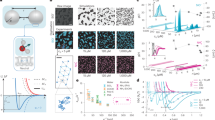Abstract
TECHNIQUES have recently been developed for modelling the dynamics of the flow of incompressible fluids using a high-speed computer1,2. The dynamical equations were solved by representing the fluid by a series of marker particles moving in a cartesian mesh, and assuming that each particle experiences a linear acceleration during a selected short interval of time. By computing the new positions and velocities of the marker particles at the end of successive time intervals, accurate calculations can be made of the motion of the fluid throughout the period of interest. This marker-and-cell technique has been applied to a study of the instability of an uncharged liquid drop of radius R and surface tension T situated in an electric field strength E. This problem, which is important in certain situations in cloud physics3, has previously been treated analytically4 by assuming that the drop retains a spheroidal shape throughout the period of deformation until the instability point is attained. The calculated instability criteria, namely, the E(R/T)&12frac; = 1.625 when the ratio of the semi-major to semi-minor axes a/b = 1.9, agree well with experimental measurements. The present numerical calculations permit a quantitative assessment to be made of the validity of the spheroidal assumption and, of greater importance, provide a description of the dynamics of the disintegration of a drop subjected to intense electrical forces. In order to save computer time the initial condition was assumed to be that a spheroidal drop of undistorted radius 0.2 cm and surface tension 70 dynes cm−1, possessing a degree of deformation represented by a/b =1.9, was introduced into a field of strength E=9,500 V cm−1, which is 4 per cent greater than the critical value deduced on the basis of the spheroidal assumption.
This is a preview of subscription content, access via your institution
Access options
Subscribe to this journal
Receive 51 print issues and online access
$199.00 per year
only $3.90 per issue
Buy this article
- Purchase on Springer Link
- Instant access to full article PDF
Prices may be subject to local taxes which are calculated during checkout
Similar content being viewed by others
References
Harlow, F. H., and Shannon, J. P., J. Appl. Phys., 38, 3855 (1967).
Harlow, F. H., and Welch, J. E., J. Phys. Fluids, 8, 2182 (1965).
Abbas, M. A., and Latham, J., Quart. J. Roy. Meteorol. Soc. (in the press).
Taylor, G. I., Proc. Roy. Soc., 280, 383 (1964).
Author information
Authors and Affiliations
Rights and permissions
About this article
Cite this article
BRAZIER-SMITH, P., LATHAM, J. Dynamics of the Disintegration of a Drop by Electrical Forces. Nature 220, 689–690 (1968). https://doi.org/10.1038/220689b0
Received:
Issue Date:
DOI: https://doi.org/10.1038/220689b0
Comments
By submitting a comment you agree to abide by our Terms and Community Guidelines. If you find something abusive or that does not comply with our terms or guidelines please flag it as inappropriate.



